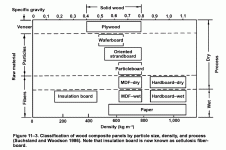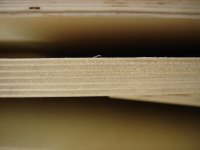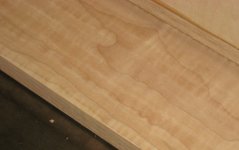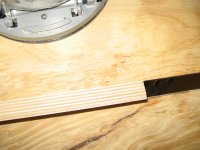...still have to get my MDF measurement done. I'm curious to see how close it comes to your 0.827.
Given the huge variability in MDF it is more likely to be different than the same.
dave
Given the huge variability in MDF it is more likely to be different than the same.
dave
Okay. I got 0.796 g/cc. A little less than 4% lower than yours.
So, we can conclude MDF is about 14% denser than BB.
Forest Products Laboratory - USDA Forest Service
Physical properties of wood, more than you ever wanted to know. Used to use this reference to design shipping skids for a product heading overseas at a previous job.
Martin
Physical properties of wood, more than you ever wanted to know. Used to use this reference to design shipping skids for a product heading overseas at a previous job.
Martin
Spruce has a good tensile along its grain and is tough. Not so sure about its multiaxis rigidity though as it can easily be bent. IMHO the best woods would have a tight grain structure with a closed cell structure.
Spruce plywood has voids within the layers that are left as is. They will only fill the voids on the outside two plys. The voids are typically knots that fall out when cut into the thin sheets used to laminate.
Baltic Birch is made to a Russian standard (GOST 3916.1-96); it is not marine grade. There are four grades; B, BB, CP, and C. The grades refer to how the voids are handled on the visible faces and internal plies. The only grades suitable for speaker cabinets are B (no voids allowed) and BB (knots are cut out and replaced with [American] football shaped patches of defect free birch). Both grade B and BB allow pin knots. If you must compromise on price, choose CP which is BB rejects and may have unfilled cracks. C is unsuitable, but you will know it by the un-sanded face wood.
"Baltic Birch" was once a term, prior to about the last 10 years, referring to Marine Grade plywood made in Scandinavian countries. They still make marine grade birch plywood in Norway and Sweden, but it's become hard to find since most lumber yards now import the cheaper Russian product. Paul Klipsch used to use the genuine scandinavian marine grade in his speakers (Hersey, Cornwall, La Scala, Belle Klipsch and Klipschorn).
Most standards I've read concerning BB, states that it is only the outer layers that affect the grades. The inner layers are all the same. That is for products on the Swedish market.
I don't think there are any BB made in Sweden anymore. I've been unable to find any manufacturers in my country. Most BB in Sweden anyway, seems to originate from Finland, Russia or the baltic countries.
You can get even more plys into your construction by using several thinner sheets instead. I do not know however, if there would be any issues by gluing them together vs. factory made of the same size, stiffness wise that is.
Dupont Corian
Density DIN ISO 1183 1.73 – 1.76 1.68 – 1.75 g/cm3 1
Flexural modulus DIN EN ISO 178 8920 – 9770 8040 – 9220 MPa 1
Flexural strength DIN EN ISO 178 49.1 – 76.4 57.1 – 74.0 MPa 1
Anyone know how to convert/compare this to the MOE/MOR data for the bamboo ply in post 3?
dave
Density DIN ISO 1183 1.73 – 1.76 1.68 – 1.75 g/cm3 1
Flexural modulus DIN EN ISO 178 8920 – 9770 8040 – 9220 MPa 1
Flexural strength DIN EN ISO 178 49.1 – 76.4 57.1 – 74.0 MPa 1
Anyone know how to convert/compare this to the MOE/MOR data for the bamboo ply in post 3?
dave
Most standards I've read concerning BB, states that it is only the outer layers that affect the grades. The inner layers are all the same. That is for products on the Swedish market.
I don't think there are any BB made in Sweden anymore. I've been unable to find any manufacturers in my country. Most BB in Sweden anyway, seems to originate from Finland, Russia or the baltic countries.
You can get even more plys into your construction by using several thinner sheets instead. I do not know however, if there would be any issues by gluing them together vs. factory made of the same size, stiffness wise that is.
BB is the Russian Standard, only applicable to the Russian product.
You would have to research the appropriate standards for Sweden, Finland, etc. Since both countries practice true silviculture by law I'm sure the standards exist.
They may be the same (ie adopted by more than one country) but it is dangerous to assume. It's my understanding that the original Swedish product was marine grade, for example.
Whether that is true or not, the Russian product is definitely NOT marine grade.
MDF - it's cheap and dense and well damped. The concerns about it pushing the resonance of the cabinet down are valid considering that there is more energy at lower frequencies but the cost advantage is very hard to ignore unless your spend on driver is >200GBP. However due to the much lower cost a more elaborate cabinet could be constructed that is much more damped than the same cost ply cabinet at the expense of size/weight (sand filled enclosures etc).
Ok for plywod layers to be uneven?
Just googled and downloaded some images of baltic birch ply cross sections.
If you look closely at the pics, you will notice:
1. Colors of the layers are different - some of the layers look light colored and hard, while others look slightly darker colored and a softer
2. Thickness of layers slighly uneven - and thickness of each individual layer is not uniform over the legth of the board(sometimes it looks slightly wavy)
I have never bothered to take such a close look at ply boards before, but is this normal?
Just googled and downloaded some images of baltic birch ply cross sections.
If you look closely at the pics, you will notice:
1. Colors of the layers are different - some of the layers look light colored and hard, while others look slightly darker colored and a softer
2. Thickness of layers slighly uneven - and thickness of each individual layer is not uniform over the legth of the board(sometimes it looks slightly wavy)
I have never bothered to take such a close look at ply boards before, but is this normal?
Attachments
the plywood layers alternate grain direction. when you cut across it you are seeing end grain on one layer and long grain on alternate layers. The core is glued together however it is and then the sheet is sanded to an even thickness. so yes the waves in the layers are normal. Baltic birch ply wood or apple ply are usually better then most in this respect.
Hey, Vics. Woods do make a difference..whether any particular difference jives with your tonal preferences is somewhat unpredictable. Duane and Dicky had their Marshall cab's made from mahog and -okoume wood, I believe- left his backs off. They swore they sounded "better". In general, "configuration trumps material". Sealed, ported or open-back all voice significantly differently..much more so than type of wood. Same configuration and same wood will sound radically different in different sizes; each panel's resonance will rise, the smaller it gets. (Still haven't answered your question) A weak construction or inadequate/thin wood will negate any resonant benefits of using a particular wood.
In hi-fi, the best cabinet is the strongest, leak-free, non-resonant, solid structure you can make. The magnitude of response-robbing resonances grows as frequency falls; the more solid, the higher and smaller the cannibalistic resonance(s) will be. MDF or HDF are very acoustically "dead" materials which don't color like solid lumber but they're heavy and don't like falling out of pickup trucks. I believe birch's claim to fame is it's light weight. I use very heavy 3/4" BC/BD-grade pine for my bass cab's with appropriate cleating, bracing, shallow dado's, etc.
In hi-fi, the best cabinet is the strongest, leak-free, non-resonant, solid structure you can make. The magnitude of response-robbing resonances grows as frequency falls; the more solid, the higher and smaller the cannibalistic resonance(s) will be. MDF or HDF are very acoustically "dead" materials which don't color like solid lumber but they're heavy and don't like falling out of pickup trucks. I believe birch's claim to fame is it's light weight. I use very heavy 3/4" BC/BD-grade pine for my bass cab's with appropriate cleating, bracing, shallow dado's, etc.
- Status
- Not open for further replies.
- Home
- Loudspeakers
- Multi-Way
- Cabinet construction - compare wood types




